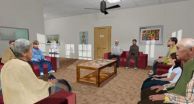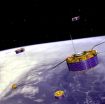(Press-News.org) DURHAM, N.C. – Millions of patients with advanced disease in palliative care settings receive oxygen therapy to help them breathe more easily. But a new study from Duke University Medical Center says roughly half of them don't benefit from the intervention, and among those who do benefit, it doesn't make a bit of difference whether they get pure oxygen or just plain old room air – both offer equal benefit.
"Offering oxygen when patients begin experiencing shortness of breath has become standard care in many places, but the practice is not based on rigorous scientific investigation," says Dr. Amy Abernethy, an oncologist and palliative care expert in the Duke Comprehensive Cancer Center and the lead author of the study appearing in the Sept. 3 issue of The Lancet. "We needed to do a study like this one to find out if what has become customary is actually meaningful and appropriate."
Abernethy says shortness of breath (also known as dyspnea) is a common symptom in very advanced stages of many diseases and disorders. Researchers say the problem is reported in 65 percent, 70 percent and 90 percent of patients nearing the end of life suffering from heart failure, lung cancer and chronic obstructive pulmonary disease, respectively. Shortness of breath is distressing for patients and their families as well, making normal activities like walking, talking, and socializing difficult. "So it is important to address it," says Abernethy.
The question becomes when and how. Clinical guidelines recommend oxygen when blood oxygen levels fall so low that a patient becomes hypoxic – when there isn't enough oxygen in the blood to keep vital functions going. But there are large numbers of patients whose oxygen levels haven't fallen into the danger zone but who experience difficulty breathing and feel they need help. "In situations like these, physicians tend to use palliative oxygen treatment out of compassion," says Abernethy. "The decision is not based on clear evidence about what do to because we haven't had any. There's never been a large, meaningful study on the role of oxygen therapy to treat unrelenting shortness of break in this population until now."
Abernethy led a multinational team of scientists in studying 239 patients in outpatient clinics in the U.S., Australia and the U.K. who were randomized to receive either oxygen or room air for one week to see if would help ease their breathing. Most of the participants had advanced chronic obstructive pulmonary disease, but some also had had lung cancer, heart failure, or other disorders.
Participants were given canisters and fitted with nasal tubes that would deliver either oxygen or room air at the nose. Neither the patients nor their caregivers knew who was getting which therapy. Participants were instructed to keep diaries of the experience and to rate any change in their symptoms using a 1 to 10 scale twice daily.
Just over half of the patients in both groups reported that the interventions offered some degree of relief. Both treatments led to equal overall improvement in shortness of breath with corresponding change in quality of life and sleep. And when improvement occurred, it came quickly – for most, within three days.
"Interestingly, for the approximately half of study participants who reported a benefit, we found it didn't make any difference if they got oxygen or just room air," says Abernethy. "The same percentage of patients in both groups reported the same degree of relief from each treatment, so we have to conclude that supplemental oxygen isn't necessary and delivering air by the nose works just as well."
Abernethy says what is clear is that some sort of air rushing near the nose does indeed help some people. But she points out that the same level of relief might be accomplished by using something as simple as a small fan. "It would certainly be less cumbersome and less costly."
"It's important to understand that we are not suggesting that physicians abandon medical gas therapy. It may indeed be helpful. But this study tells us that it is not the oxygen itself that is making the difference, and if treatment is not improving symptoms after a few days, then it's ok to stop treatment and try something else.
The old adage just isn't true that stopping palliative oxygen is akin to removing a sustaining, meaningful treatment when people are most vulnerable."
Abernethy says that when it comes to care toward the end of life, timing matters more than ever. "We need to be smarter at what we do for our patients – and when we do it. As physicians, we only have a very short time to dip into our toolbox to find the right solution. It's studies like this that can help inform our decisions and ultimately give our patients the best care possible."
###
The study was funded by grants from the National Institute on Aging of the NIH, the Australian National Health and Medical Research Council, the Duke Institute for Care at the End of Life and the Doris Duke Charitable Foundation.
Colleagues who contributed to the study include senior author David Currow, from Flinders University in Australia; James Herndon, James Tulsky, Jane Wheeler and Jennifer Marcello, from Duke; Christine McDonald, Katherine Clark, Iven Young, Peter Frith, and Alan Crockett, from Australia; Janet Bull of Four Seasons, Flat Rock, North Carolina; and Andrew Wilcock and Sara Booth from the U.K
END
Lupus Research Institute-funded researcher Betty Tsao, PhD, at the University of California Los Angeles has discovered that humans—males in particular—with a variant form of the immune receptor gene "Toll Like Receptor 7 (TLR7)" are at increased risk of developing the autoimmune disease systemic lupus erythematosus (lupus). This breakthrough finding offers renewed hope for developing more targeted treatments.
The powerful finding recently published in the Proceedings of the National Academy of Sciences (PNAS) represents additional strong evidence from human cells—as opposed ...
VIDEO:
Dr. Gail Smith, a veterinary orthopedic surgeon, discusses the PennHIP method for diagnosing a dog's susceptibility to osteoarthritis.
Click here for more information.
PHILADELPHIA –- A study comparing a University of Pennsylvania method for evaluating a dog's susceptibility to hip dysplasia to the traditional American method has shown that 80 percent of dogs judged to be normal by the traditional method are actually at risk for developing osteoarthritis and hip dysplasia, ...
Virtual characters can behave according to actions carried out unconsciously by humans. Researchers at the University of Barcelona have created a system which measures human physiological parameters, such as respiration or heart rate, and introduces them into computer designed characters in real time.
"The ultimate aim is to develop a method which allows humans to unconsciously relate with some parts of the virtual environment more intensely than with others, and that they are encouraged only by their own physiological responses to the virtual reality shown", Christoph ...
Cluster has spent a decade revealing previously hidden interactions between the Sun and Earth. Its studies have uncovered secrets of aurora, solar storms, and given us insight into fundamental processes that occur across the Universe. And there is more work to do.
The aurora, those dancing lights in the polar skies, are but the visible manifestation of an invisible battle taking place above our heads. Supersonic particles from the Sun collide with our planet's magnetic field every day. Most are deflected away but some are trapped by Earth's magnetism and accelerated to ...
CAMBRIDGE, Mass., Sept. 2, 2010 -- Engineers at Harvard University have created a millionth-scale automobile differential to govern the flight of minuscule aerial robots that could someday be used to probe environmental hazards, forest fires, and other places too perilous for people.
Their new approach is the first to passively balance the aerodynamic forces encountered by these miniature flying devices, letting their wings flap asymmetrically in response to gusts of wind, wing damage, and other real-world impediments.
"The drivetrain for an aerial microrobot shares ...
The Department of Computer Science and Technology, Peking University, Beijing, China, has shown that a novel dynamic memory mapping (DMM) model brings about additional flexibility to virtual resource management, leading to the feature-adjustable design of a virtual machine monitor (VMM). The study is reported in Issue 53 (June, 2010) of SCIENCE CHINA Information Sciences because of its significant research value.
Memory is one of the most frequently accessed components in virtual machine (VM) systems. Because a VM's memory requirement varies according to the running applications, ...
The Key Laboratory of Applied Superconductivity, Institute of Electrical Engineering, Chinese Academy of Sciences, Beijing, and China Research have collaborated to reveal the heat treatment effects on the superconducting properties of Ag-doped Sr0.6K0.4Fe2As2 compounds. Because of its significant research value, the study is reported in issue 7 of SCIENCE CHINA Physics, Mechanics & Astronomy.
Previously, our group studied the effect of adding Ag to polycrystalline Sr0.6K0.4Fe2As2 and found that the critical current density Jc and the irreversibility field increase markedly. ...
The State Key Laboratory of Virtual Reality Technology and Systems, Beihang University in Beijing, has proposed an image based modeling method for inhomogeneous single-scattering participating media whose density fields may contain high frequency details [1]. This work could reduce the difficulty in capturing real-world participating media, which can be applied to 3D games, film production, virtual reality systems, etc. This study is reported in Volume 53 (June, 2010) of the Science China Information Sciences journal because of its significant research value.
Realistic ...
Nurses have a responsibility to respect and support patients who use cannabis for medicinal purposes, but must stay within the law and follow professional guidance at all times, according to a research review in the September issue of the Journal of Clinical Nursing.
Dr Anita Green and Dr Kay De-Vries studied more than 50 published papers, together with professional and Government guidance documents, official reports and media coverage, from 1996 to 2009.
They point out that the fact that the cannabis is usually obtained illegally can have consequences for those who ...
ESA's Herschel infrared space observatory has discovered that ultraviolet starlight is the key ingredient for making water in space. It is the only explanation for why a dying star is surrounded by a gigantic cloud of hot water vapour.
Every recipe needs a secret ingredient. When astronomers discovered an unexpected cloud of water vapour around the old star IRC+10216 in 2001, they immediately began searching for the source. Stars like IRC+10216 are known as carbon stars and are thought not to make much water. Initially they suspected the star's heat must be evaporating ...



